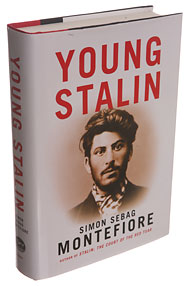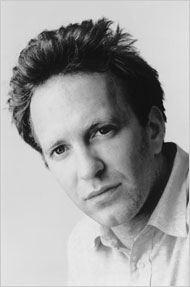| Want to send this page or a link to a
friend? Click on mail at the top of this window. |
 |
| TONY CENICOLA/THE NEW YORK TIMES |
|
|
| ___________________________ |
| By Simon Sebag Montefiore. |
| Illustrated. Alfred A. Knopf. |
| ___________________________ |
FOR decades historians accepted the
portrait of Stalin painted by his rivals. He was, in the words of one political adversary,
Nikolai Sukhanov, “a gray blur,” a mediocre party hack who managed, through
stealth and intrigue, to wrest the levers of power from the brilliant revolutionaries
surrounding him. History, in this case, was written by the losers, notably Leon Trotsky,
who never could accept that he had been bested by a pockmarked thug from Georgia with
shaky intellectual credentials.
In “Young Stalin,” Simon Sebag Montefiore’s meticulously researched,
authoritative biography of Stalin’s early years, the blur comes into sharp focus.
Building on the revisionist studies of Robert Service and Richard Overy, Mr. Montefiore
offers a detailed picture of Stalin’s childhood and youth, his shadowy career as a
revolutionary in Georgia and his critical role during the October Revolution. No one,
henceforth, need ever wonder how it was that Stalin found his way into Lenin’s inner
circle, or took his place in the ruling troika that assumed power after the storming of
the Winter Palace.
 |
| Simon Sebag Montefiore/ Knopf |
|
Just as he did in “Stalin: The Court of the Red Tsar,” his lurid, grisly
chronicle of Stalin in power, Mr. Montefiore has found his devil in the details, working
his way with a fine-toothed comb through previously unread archival material in Russia and
in Georgia, where he uncovered a memoir written by Stalin’s mother. Throughout, he
connects dots and fills in the blanks, uncovering facts that Stalin, once he assumed
power, took great pains to conceal.
No detail is too minute. We learn that Stalin, while living in exile in Vologda in
1911, visited the library 17 times in less than two months. No source, it seems, lies
beyond the author’s reach. Mr. Montefiore located a 109-year-old cousin of
Stalin’s first wife, Ekaterina Svanidze. Her memory still sharp, Mr.
Montefiore’s eyewitness corroborated the assertion, made by other family members,
that Ms. Svanidze died in 1907 of typhus, not tuberculosis, as historians mistakenly
believed. A small point, but the accretion of direct testimony adds color to the
traditional monotone picture of Stalin, bringing him to life on the page.
Stalin was, Mr. Montefiore writes, “that rare combination: both
‘intellectual’ and killer.” The roots of violence ran deep in his family
life and in Gori, his hometown, where street brawling was the principal sport. Soso, as
Stalin, born Josef Djugashvili, was called, suffered savage beatings from both his
alcoholic father and his doting mother, who alternated smothering affection with harsh
corporal punishment. When Stalin, later in life, asked his mother why she had beaten him
so much, she replied, “It didn’t do you any harm.” A brilliant but
rebellious student at the religious schools he attended, and a published poet of great
promise, Soso took up radical politics while still in his teens, his approach already
shaped by the tactics of the seminary’s administration — “surveillance,
spying, invasion of inner life, violation of feelings,” as he later described them.
Taking the name Koba, that of a fictional Caucasian bandit-hero (Stalin, or “man of
steel,” would come much later), he embarked on a career as an underground political
agitator, his life punctuated by multiple arrests and years spent in internal exile.
Gaunt and darkly handsome despite the facial scars left by smallpox, and blessed with a
beautiful singing voice, Koba enchanted women throughout his young manhood and left
several illegitimate children as proof. He had a mesmerizing effect on men as well.
“His style, manners were totally Georgian, yet there was something utterly
original, something hard to fathom, both leonine and feline about him,” a Georgian
Menshevik wrote of this fascinating political opponent.
Mr. Montefiore sheds new light on Stalin’s wild years as a kind of revolutionary
gang leader in the Caucasus, putting him at the center of robberies, kidnappings, arson
attacks, extortion schemes and executions of suspected traitors. He makes a very strong
case that Stalin burned down the Rothschilds’ refinery warehouse in the oil boom town
Batumi in January 1902 and thereafter used this act as leverage in extorting protection
money from other oil barons. In addition to agitating among workers and fomenting strikes
and riots, Stalin specialized in daring, extremely violent bank heists, whose considerable
proceeds helped Lenin finance the Bolshevik Party.
Stalin thrived on violence, subterfuge and dark conspiracy. He fully subscribed to the
Leninist ideal of the Marxist revolutionary as a man outside normal society and moral law,
a pitiless instrument of the working class. The “black work” that Stalin made
his métier became standard operating procedure for the Soviet government. Stalin, like
his fellow Bolsheviks, never left the shadow world of spies, double agents and criminal
conspiracy.
Mr. Montefiore dismisses, perhaps for good, the theory that Stalin was an agent for the
Okhrana, the czarist secret police. He spent far too much time in prison or exile, for one
thing. On the occasions when he met with agents, Mr. Montefiore points out, Stalin was
receiving rather than giving intelligence.
Stalin won Lenin’s wholehearted approval from the moment they met in 1905. In
Lenin’s terms he was, quite clearly, one of the highly desirable “men of
action,” rather than one of the “tea-drinkers.”
With time their relationship only deepened. Much to Lenin’s surprise, Stalin
submitted a brilliant position paper on party policy toward nationalities within the
Russian empire. The killer really was an intellectual, and certainly no bureaucrat. Mr.
Montefiore notes, shrewdly, that “everything with Stalin was political, but he worked
in an eccentric, structureless, unbureaucratic, almost bohemian style that would not have
succeeded in any other government, then or now.” Mr. Montefiore successfully captures
“the sheer weird singularity of the man” and the lethal instincts that propelled
him to the summit of power. Surrounded by hard, ruthless men, Stalin proved to be the
hardest and most ruthless. The hands trained in black work had the strongest grip.
Copyright 2007 The New York Times Company. Reprinted from The New York Times, Book
Review, of Sunday, October 21, 2007.
| Wehaitians.com, the scholarly journal of
democracy and human rights |

